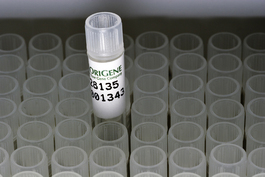ATF5 (NM_001290746) Human Untagged Clone
CAT#: SC335046
ATF5 (untagged) - Human activating transcription factor 5 (ATF5), transcript variant 3
"NM_001290746" in other vectors (1)
Product Images

Specifications
| Product Data | |
| Type | Human Untagged Clone |
| Tag | Tag Free |
| Symbol | ATF5 |
| Synonyms | ATFX; HMFN0395 |
| Vector | pCMV6-Entry |
| Sequence Data |
>SC335046 representing NM_001290746.
Blue=Insert sequence Red=Cloning site Green=Tag(s) ATGTCACTCCTGGCGACCCTGGGGCTGGAGCTGGACAGGGCCCTGCTCCCAGCTAGTGGGCTGGGATGG CTCGTAGACTATGGGAAACTCCCCCCGGCCCCTGCCCCCCTGGCTCCCTATGAGGTCCTTGGGGGAGCC CTGGAGGGCGGGCTTCCAGTGGGGGGAGAGCCCCTGGCAGGTGATGGCTTCTCTGACTGGATGACTGAG CGAGTTGATTTCACAGCTCTCCTCCCTCTGGAGCCTCCCTTACCCCCCGGCACCCTCCCCCAACCTTCC CCAACCCCACCTGACCTGGAAGCTATGGCCTCCCTCCTCAAGAAGGAGCTGGAACAGATGGAAGACTTC TTCCTAGATGCCCCGCCCCTCCCACCACCCTCCCCGCCGCCACTACCACCACCACCACTACCACCAGCC CCCTCCCTCCCCCTGTCCCTCCCCTCCTTTGACCTCCCCCAGCCCCCTGTCTTGGATACTCTGGACTTG CTGGCCATCTACTGCCGCAACGAGGCCGGGCAGGAGGAAGTGGGGATGCCGCCTCTGCCCCCGCCACAG CAGCCCCCTCCTCCTTCTCCACCTCAACCTTCTCGCCTGGCCCCCTACCCACATCCTGCCACCACCCGA GGGGACCGCAAGCAAAAGAAGAGAGACCAGAACAAGTCGGCGGCTCTGAGGTACCGCCAGCGGAAGCGG GCAGAGGGTGAGGCCCTGGAGGGCGAGTGCCAGGGGCTGGAGGCACGGAATCGCGAGCTGAAGGAACGG GCAGAGTCCGTGGAGCGCGAGATCCAGTACGTCAAGGACCTGCTCATCGAGGTTTACAAGGCCCGGAGC CAGAGGACCCGTAGCTGCTAG |
| Restriction Sites |
SgfI-MluI
Plasmid Map

|
| ACCN | NM_001290746 |
| Insert Size | 849 bp |
| OTI Disclaimer | Our molecular clone sequence data has been matched to the reference identifier above as a point of reference. Note that the complete sequence of our molecular clones may differ from the sequence published for this corresponding reference, e.g., by representing an alternative RNA splicing form or single nucleotide polymorphism (SNP). |
| Product Components | The ORF clone is ion-exchange column purified and shipped in a 2D barcoded Matrix tube containing 10ug of transfection-ready, dried plasmid DNA (reconstitute with 100 ul of water). |
| Reconstitution | 1. Centrifuge at 5,000xg for 5min. 2. Carefully open the tube and add 100ul of sterile water to dissolve the DNA. 3. Close the tube and incubate for 10 minutes at room temperature. 4. Briefly vortex the tube and then do a quick spin (less than 5000xg) to concentrate the liquid at the bottom. 5. Store the suspended plasmid at -20°C. The DNA is stable for at least one year from date of shipping when stored at -20°C. |
| Reference Data | |
| RefSeq | NM_001290746.1 |
| RefSeq Size | 2059 bp |
| RefSeq ORF | 849 bp |
| Locus ID | 22809 |
| UniProt ID | Q9Y2D1 |
| Cytogenetics | 19q13.33 |
| Protein Families | Transcription Factors |
| MW | 30.7 kDa |
| Gene Summary | Transcription factor that either stimulates or represses gene transcription through binding of different DNA regulatory elements such as cAMP response element (CRE) (consensus: 5'-GTGACGT[AC][AG]-3'), ATF5-specific response element (ARE) (consensus: 5'-C[CT]TCT[CT]CCTT[AT]-3') but also the amino acid response element (AARE), present in many viral and cellular promoters. Critically involved, often in a cell type-dependent manner, in cell survival, proliferation, and differentiation (PubMed:10373550, PubMed:15358120, PubMed:21212266, PubMed:20654631). Its transcriptional activity is enhanced by CCND3 and slightly inhibited by CDK4 (PubMed:15358120). Important regulator of the cerebral cortex formation, functions in cerebral cortical neuroprogenitor cells to maintain proliferation and to block differentiation into neurons. Must be down-regulated in order for such cells to exit the cycle and differentiate (By similarity). Participates in the pathways by which SHH promotes cerebellar granule neuron progenitor cells proliferation (By similarity). Critical for survival of mature olfactory sensory neurons (OSN), directs expression of OSN-specific genes (By similarity). May be involved in osteogenic differentiation (PubMed:22442021). Promotes cell proliferation and survival by inducing the expression of EGR1 sinergistically with ELK1. Once acetylated by EP300, binds to ARE sequences on target genes promoters, such as BCL2 and EGR1 (PubMed:21791614). Plays an anti-apoptotic role through the transcriptional regulation of BCL2, this function seems to be cell type-dependent (By similarity). Cooperates with NR1I3/CAR in the transcriptional activation of CYP2B6 in liver (PubMed:18332083). In hepatic cells, represses CRE-dependent transcription and inhibits proliferation by blocking at G2/M phase (PubMed:22528486, PubMed:18701499). May act as a negative regulator of IL1B transduction pathway in liver (PubMed:24379400). Upon IL1B stimulus, cooperates with NLK to activate the transactivation activity of C/EBP subfamily members (PubMed:25512613). Besides its function of transcription factor, acts as a cofactor of CEBPB to activate CEBPA and promote adipocyte differentiation (PubMed:24216764). Regulates centrosome dynamics in a cell-cycle- and centriole-age-dependent manner. Forms 9-foci symmetrical ring scaffold around the mother centriole to control centrosome function and the interaction between centrioles and pericentriolar material (PubMed:26213385).[UniProtKB/Swiss-Prot Function] Transcript Variant: This variant (3, also known as beta) has an alternate 5' UTR exon, compared to variant 1. Variants 1, 2 and 3 encode the same protein. Sequence Note: This RefSeq record was created from transcript and genomic sequence data to make the sequence consistent with the reference genome assembly. The genomic coordinates used for the transcript record were based on transcript alignments. |
Documents
| Product Manuals |
| FAQs |
| SDS |
Resources
Other Versions
| SKU | Description | Size | Price |
|---|---|---|---|
| RC237152 | ATF5 (myc-DDK-tagged) - Human activating transcription factor 5 (ATF5), transcript variant 3 |
USD 420.00 |
{0} Product Review(s)
Be the first one to submit a review






























































































































































































































































 Germany
Germany
 Japan
Japan
 United Kingdom
United Kingdom
 China
China
